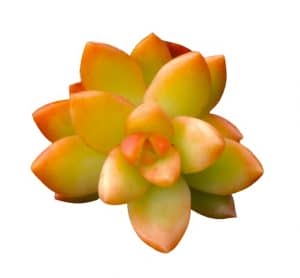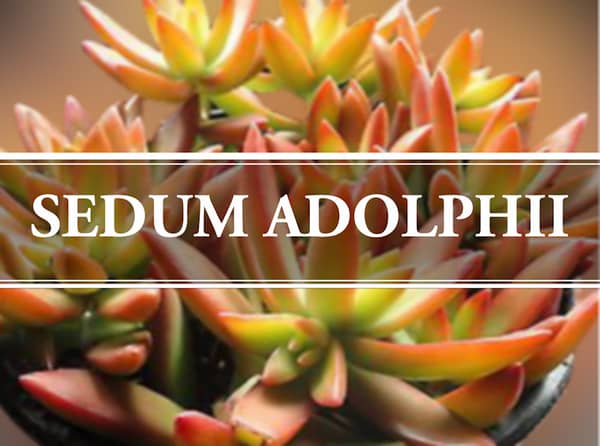Succulents are popular to grab attention and admiration through their unique and beautiful foliage. We are going to discuss another succulent gift of nature, the Sedum adolphii plant. This trailer belongs to the rocky mountains of Mexico.
The short growing plant remains under 12 inches in height. The small, greenish-yellow, succulent leaves join in alternate patterns to form rosettes. While enjoying the sun of warm days, these leaves get a reddish tint on their borders making them look prettier.
These plants are perfect to form groundcovers, pots, containers and hanging baskets. They prefer outdoor growth. However, you can grow them indoors in bright light. Interesting? Let us know more about the care and propagation of the Adolphii sedum plant along with its common cultivars.
Sedum Adolphii Classification
Family: Crassulaceae
Genus: Sedum
Species: S. adolphii
Let us introduce the genus to get a better understanding of the plant.
Genus Sedum
Carl Linnaeus first described the genus and this specific plant Adolphii, back in 1753. It consisted of around 550 species which later reduced to about 456. Around 100 of these were later added to other genera including Hylotelephium and Rhodiola. These natives of the Northern Hemisphere are commonly called ‘Stone Crops’.
This is a diverse and genetically complex genus. The main feature of the genus is its thick succulent leaves. Sedums include different growing habits including vines and shrubs. Moreover, they may be annual, biennial, or perennial. These plants grow flowers with numerous petals.
Sedum Adolphii Common Names
Apart from the scientific names, the plants are given different common names. These are about some specific features of every plant.
The yellowish golden shade of the foliage makes the plant commonly known as;
- Sedum adolphii Golden Glow.
- S. Adolphii Golden.
Features of the Sedum Adolphii Plant

Height and Structure
- The plant grows from 8 to 14 inches in height. These quick growers can expand up to 2 feet on maturity.
Leaves
- Each banana-shaped leaf is about an inch or two in size forming the 2 to 4 inches rosette.
Flowers
- Small, white, star-shaped flowers with subtle fragrance start blooming in the fall until the spring of next year. However, flowering is not seen commonly in these plants.
- The inflorescences are flat-topped and look somewhat like the umbels in shape.
Toxicity
Adolphiis are generally considered non-toxic for both humans and pets. However, it is never healthy for kids and the fur babies to chew on houseplants.
S. Adolphii Cultivars
The plant is hybridized on large scale to create several hybrids. Let us have a look at the popular cultivars;
Sedum Adolphii Firestorm
The cultivar Firestorm Sedum was first introduced in 2014 by the Huntington Botanic Garden. The banana-shaped succulent leaves are about 2 to 3 inches in size and have with pointed ends.
Other cultivars include the Sedum adolphii Green and the Sedum adolphii Lime Gold. Many people and growers even consider these names as the ‘Other Names’ for the parent plant.
The care and all other growing requirements are the same as mentioned below in the next section.
Sedum Adolphii Care
The plant along with its cultivars needs simple succulent care.
Quick Guide
Water: Medium water requirement. Water frequently in the growing season and rarely in fall and winter.
Sunlight: Full sun to partial shade.
Humidity: Average.
Fertilizer: Monthly dose of dilute fertilizer in the growing season.
Let us have a detailed understanding of ‘how to grow a Sedum Adolphii Golden Sedum Plant’.
Water Requirement
A simple ‘soak and dry’ strategy work well for the plant. Once established, they develop drought resistance. You can keep them growing happily without water for weeks. However, you need to water religiously before that.
Water the soil generously and let it drain through the drainage holes. Water right after the soil gets completely dry.
Succulents are prone to fungus and root rot. So, make sure you water the soil and not the foliage.
The watering frequency depends upon the temperature, humidity and sunlight availability. In summer, the watering frequency should be around once or thrice a week. On the other hand, once in two to three weeks is enough for the fall and winter.
Over-watering and soggy soil are highly unsuitable for succulents.
Sunlight Requirement
These peeps love to stay in full sun and can do well in partial shade. They must get an exposure of 5 to 6 hours of sun. On the other hand, you can compensate for the indoor peeps with the bright growing light.
Temperature Requirement
A temperature range of 65 to 80 °F is ideal for the majority of the succulents. These plants come with poor tolerance for cold and frost. So, make sure you transfer them to some warm indoor spot before the fall.
If the temperature falls below 20 °F in your region, it is better to grow it in the container. This will help you to carry and save the plant easily from the cold winter.
Humidity Requirement
The sedum adolphii golden glow and the cultivars are fine with a range of humidity levels. These peeps will be happy in the humidity level of the area. Moreover, you don’t need to do any extra efforts to maintain the moisture level.
People ask about misting the succulents. Experts recommend avoiding misting the foliage. This will be a favour for your plant saving it from different issues like fungus and root rot.
Soil Requirement
Just like the majority of other succulents, these plants need well-draining soil. A mixture of peat moss and succulent mix in equal proportions makes a nice choice.
Fertilizer Requirement
Use a simple succulent fertilizer in the diluted form once a month in spring and summer. It is better t use half of the stated dose. This will minimize the chances of over-fertilization and save these peeps form resulting in drying out.
Stop fertilizing in fall and winter. The reason being these summer dominant peeps don’t need any additional nutritional in the cold days.
Pruning Requirements
You can remove the older leaves and rosettes to maintain a healthy appearance of the plant.
Growth Zone
The USDA hardiness zones are 9a to 11b from 20 F to 50 F. The dwellers of these regions can grow the plant outdoors without any hassle of transferring them indoors.
Sedum Adolphii Propagation
These plants are easy-to-propagate and grow pretty quickly. You can make new plants in the summer and enhance your plant collection. Popular propagating methods include;
- Leaf-cuttings.
- Stem-cuttings.
Season:
The best time to try propagating a succulent is spring until the middle of the summer. Howbeit, you may try up till the end of the summer.
Propagation by leaf-cuttings
- Twist or cut a few healthy leaves from a plant. Make sure you cut finely and no leaf is left on the stem. Let it stay for a day or two to form a callus.
- Now, place the leaves on the moist, well-draining growing mixture.
- This leaf will develop roots and shoots in 3 to 5 weeks.
- After this development, you can plant the roots in the soil.
Propagation by stem-cuttings
- Instead of the leaves, you can also use stem cuttings. Cut a 5 to 7 inches long stem cutting and plant it in moist soil at a depth of about 3 inches.
Growth Timeline
Let us have a look at an estimated growth time-line. This is supposed to give you a better understanding of the growth and initial care of the plant.
Day 1–Day 30: Place the growing set up in a warm place with plenty of light. Keep the growing mix moist by spraying water right after the soil gets about 90% dry. Root development will be seen after the 3rd week.
Day 30 to Day 60: Keep caring for your plantlets and you will see the shoot development around the fifth week.
Day 60 onwards: After about 2 months, you will see well-grown baby Adolphii plantlets. Finally, you can plant the leaf-propagations in the soil and let them grow like their parents. Simply follow the care mentioned in the previous section and your new peeps are good to go.
So, are you ready to make some new Sedum adolphii golden plants? Your plant-loving friends are surely going to love you for presenting a growing baby succulent.
Related Post:
Summary
Sedum adolphii is a succulent that belongs to the rocky mountains of Mexico. The greenish-yellow succulent leaves join to form rosettes. In summer, these leaves get a beautiful reddish tint on their borders by staying in sun.
This rare bloomer produces white star-shaped flowers in the fall and winter season. This plant grows up to 14 inches on maturity. This short height makes it a suitable choice for rock gardens, ground covers, hanging baskets and pots.
These peeps can survive pretty well indoors, howbeit; they love to stay in the full outdoor sun. Full sun to partial shade and frequent watering in warm months are important to keep these succulents happy.
These succulents and their numerous cultivars with slightly different appearances are nice additions to the list of attractive succulents, for sure. Last but not the least, these plants are added to the list of non-toxic plants.

